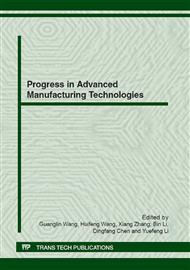p.3
p.8
p.13
p.17
p.21
p.26
p.31
p.36
p.41
Preparation Technology and Surface Finishing Characteristics Research of New Magnetic Abrasive Tools
Abstract:
According to the fact that the common machining medium used in magnetic abrasive finishing (magnetic abrasive) possessed disadvantages such as high preparation cost, easier to disperse in finishing process, and low utilization and repeat -utilization, this paper puts forward spherical magnetic abrasive of a certain size as magnetic abrasive machining medium, discusses the preparation techniques, establishes the mathematical model of finishing, and analyses the main performance parameter influencing finishing quality and finishing efficiency. Compared with magnetic grinding, spherical magnetic abrasive is not easy to disperse, can be re-used, having long service life and high finishing efficiency and quality. It is a magnetic finishing medium hasing development research value.
Info:
Periodical:
Pages:
21-25
Citation:
Online since:
August 2012
Authors:
Price:
Сopyright:
© 2012 Trans Tech Publications Ltd. All Rights Reserved
Share:
Citation:


